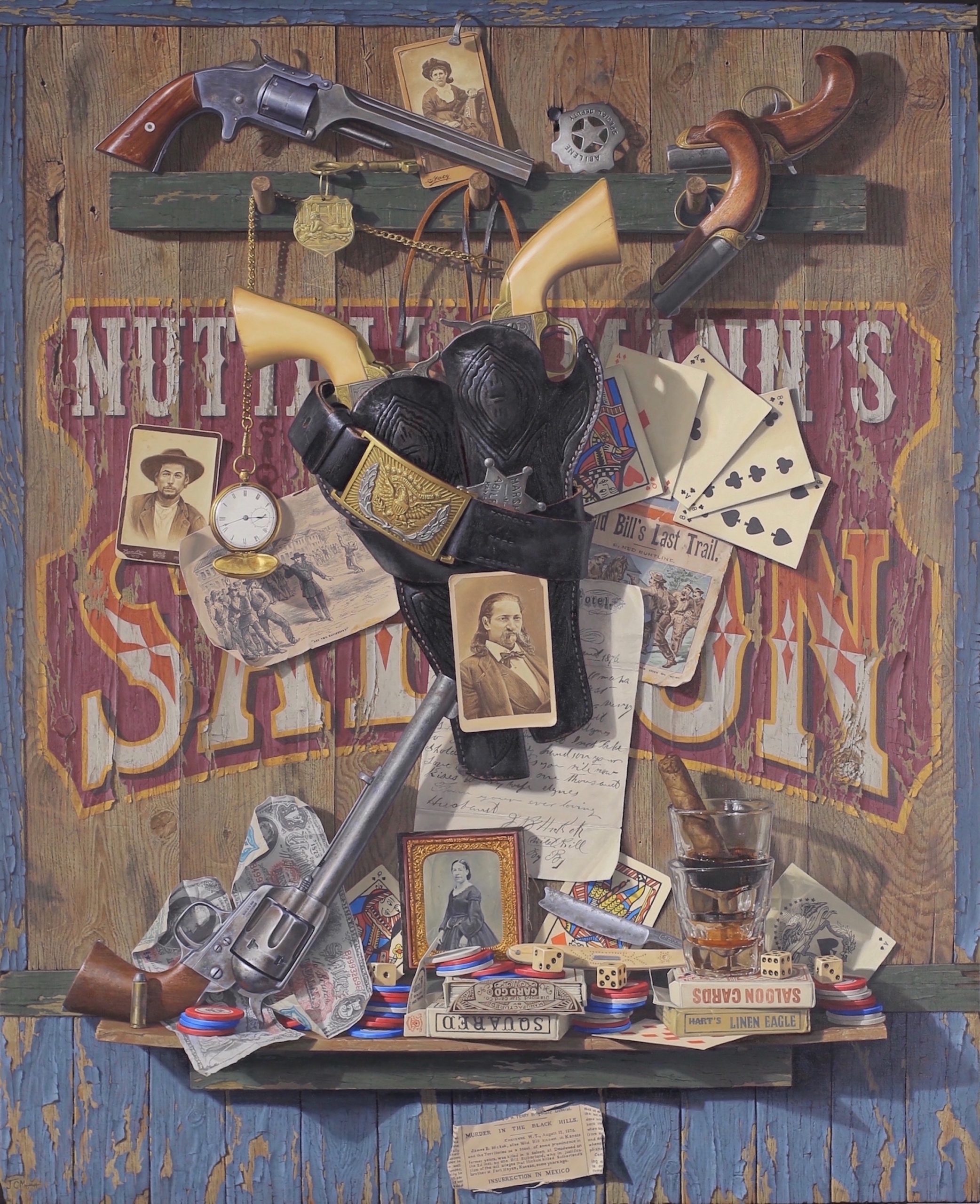About the artwork
Bill's Last Trail 32 x 26, Oil on linen canvas Aces and Eights Series Bill's Last Trail explores the death of legendary scout, gunfighter, lawman and gambler James Butler Hickok, aka Wild Bil, using depictions of authenticated Hickok memorabilia whenever possible. The title of the painting comes from a dime novel titled Wild Bill's Last Trail, written by another western legend Ned Buntline. nI the center hangs Bill's matching ivory gripped 36-caliber 1851 Model Navy Colts holstered ni a reverse draw dual rig with his Civil War Union Army enlisted man's brass belt buckle. Nestled in the coiled gun belt is a badge to commemorate his time as Marshall of Abilene, Kansas and tucked in the bottom of the gun belt is a cabinet photo card of Bil, age 39, taken in Cheyenne, Wyoming Territory, shortly before his death. On the ledge above the right Colt's grip leans a badge to honor Abilene Special Deputy Mike Williams, shot and killed mistakenly by Hickok as he was coming to the marshall's aid during Hickok's altercation with saloon owner Phil Coe. The death of Williams haunted Hickok for the rest of his life and shortly after the tragedy Bil hung up his pistols and badge for good. The image on the photo card to the left of the rig is that of Springfield, Missouri gambler Davis Tut, killed by Hickok purportedly over a gold Waltham repeater pocket watch, dear to Hickok, which he lost to Tutt in a poker game. The next day, seeing Tut wearing the watch was the last straw for Hickok, the two having a history of disagreements over gambling debts and a woman. They faced of ni Springfield's town square on July 21, 1865 ni the first quick draw gunfight of its kind. Firing almost simultaneously, Tutt's bullet missed while Hickok's found Tutt's heart, killing him. The wood engraved illustration of the incident, slipped behind the Waltham watch, appeared with an article ni Harper's Weekly magazine shortly after and propelled Hickok to national fame as the West's foremost gunfighter and folk hero. The tintype image resting on the vintage card decks among the saloon gambling accoutrements on the lower shelf is 50 year old Cheyenne circus owner Agnes Thatcher Lake, whom Hickok married in March of 1876. His straight razor lies nearby while above, behind the holster, is a love letter to Agnus penned by Hickok at the Metropolitan Hotel in Omaha, Nebraska while he travelled to the Dakota Territory in search of gold just a couple of months after their marriage. The photo card propped on the upper ledge is a rare image of frontierswoman, sharpshooter and story teller Martha Jane Cannary in woman's garb. Better known as Calamity Jane, she was more often photographed armed and dressed in mens buckskins. Jane claimed to be Bill's companion during his last days in Deadwood and was buried close by him after her death in 1903. In front of Jane is perched the rose wood gripped 32-caliber Smith &Wesson Model No. 2 Army five shot revolver carried by Hickok at the time of his death. To the left are Bill's dual hide-out 41-caliber Williamson derringers, typical gambler's armament. While engaged ni a game of five card poker at Nuttall and Mann's Saloon ni Deadwood, Dakota Territory, Wild Bil is shot ni the back of the head at point blank range by drifter, drunk and gambler Jack McCal with a 45-caliber Colt Model 1873 Single Action Army revolver on August 2, 1876-McCall is misidentified as Bil Sutherland ni the clipping of the August 13, 1876 New York Herald article depicted at the bottom of the painting. According to legend, the make-up of Bill's poker hand was two pairs, black suited aces and eights with an unknown hole card, or according to others a queen of diamonds, jack of diamonds or nine of diamonds. But a witness, who claimed to have picked up the cards off the saloon's floor, states they were the the ace of clubs and ace of diamonds, two black eights with the queen of hearts as the 'kicker'. By the 1920's, Bill's hand had became popularized as the "Dead Man's Hand." Award winning California Artist John C Moffit has been creating fine artwork and murals for the entertainment industry for decades. His Aces and Eights Series of trompe l'oeil oil paintings depicts actual historical objects ni compositions that weave stories celebrating the facts and myths surrounding the demise of the old west's most notorious characters.Medium Details
oil on linen
Condition
Provenance
This painting is part of the 18th Annual International Guild of Realism Show in Scottsdale, AZ being hosted by T.H. Brennen Fine Art.
Bill’s Last Trail
Oil
Genre
32 H x 26 W in
Bill’s Last Trail 32 x 26, Oil on linen canvas Aces and Eights Series Bill’s Last Trail explores the death of legendary scout, gunfighter, lawman and gambler James Butler Hickok,…
Seller: I.G.O.R. Show in Scottsdale
PRICE
$20,500
SHIPPING
Shipping arrangements are handled between buyers and sellers.
SECURE PAYMENT
Secure transactions by credit card, or ACH payment.
Have a question? Visit our help center.
About the artwork
Bill's Last Trail 32 x 26, Oil on linen canvas Aces and Eights Series Bill's Last Trail explores the death of legendary scout, gunfighter, lawman and gambler James Butler Hickok, aka Wild Bil, using depictions of authenticated Hickok memorabilia whenever possible. The title of the painting comes from a dime novel titled Wild Bill's Last Trail, written by another western legend Ned Buntline. nI the center hangs Bill's matching ivory gripped 36-caliber 1851 Model Navy Colts holstered ni a reverse draw dual rig with his Civil War Union Army enlisted man's brass belt buckle. Nestled in the coiled gun belt is a badge to commemorate his time as Marshall of Abilene, Kansas and tucked in the bottom of the gun belt is a cabinet photo card of Bil, age 39, taken in Cheyenne, Wyoming Territory, shortly before his death. On the ledge above the right Colt's grip leans a badge to honor Abilene Special Deputy Mike Williams, shot and killed mistakenly by Hickok as he was coming to the marshall's aid during Hickok's altercation with saloon owner Phil Coe. The death of Williams haunted Hickok for the rest of his life and shortly after the tragedy Bil hung up his pistols and badge for good. The image on the photo card to the left of the rig is that of Springfield, Missouri gambler Davis Tut, killed by Hickok purportedly over a gold Waltham repeater pocket watch, dear to Hickok, which he lost to Tutt in a poker game. The next day, seeing Tut wearing the watch was the last straw for Hickok, the two having a history of disagreements over gambling debts and a woman. They faced of ni Springfield's town square on July 21, 1865 ni the first quick draw gunfight of its kind. Firing almost simultaneously, Tutt's bullet missed while Hickok's found Tutt's heart, killing him. The wood engraved illustration of the incident, slipped behind the Waltham watch, appeared with an article ni Harper's Weekly magazine shortly after and propelled Hickok to national fame as the West's foremost gunfighter and folk hero. The tintype image resting on the vintage card decks among the saloon gambling accoutrements on the lower shelf is 50 year old Cheyenne circus owner Agnes Thatcher Lake, whom Hickok married in March of 1876. His straight razor lies nearby while above, behind the holster, is a love letter to Agnus penned by Hickok at the Metropolitan Hotel in Omaha, Nebraska while he travelled to the Dakota Territory in search of gold just a couple of months after their marriage. The photo card propped on the upper ledge is a rare image of frontierswoman, sharpshooter and story teller Martha Jane Cannary in woman's garb. Better known as Calamity Jane, she was more often photographed armed and dressed in mens buckskins. Jane claimed to be Bill's companion during his last days in Deadwood and was buried close by him after her death in 1903. In front of Jane is perched the rose wood gripped 32-caliber Smith &Wesson Model No. 2 Army five shot revolver carried by Hickok at the time of his death. To the left are Bill's dual hide-out 41-caliber Williamson derringers, typical gambler's armament. While engaged ni a game of five card poker at Nuttall and Mann's Saloon ni Deadwood, Dakota Territory, Wild Bil is shot ni the back of the head at point blank range by drifter, drunk and gambler Jack McCal with a 45-caliber Colt Model 1873 Single Action Army revolver on August 2, 1876-McCall is misidentified as Bil Sutherland ni the clipping of the August 13, 1876 New York Herald article depicted at the bottom of the painting. According to legend, the make-up of Bill's poker hand was two pairs, black suited aces and eights with an unknown hole card, or according to others a queen of diamonds, jack of diamonds or nine of diamonds. But a witness, who claimed to have picked up the cards off the saloon's floor, states they were the the ace of clubs and ace of diamonds, two black eights with the queen of hearts as the 'kicker'. By the 1920's, Bill's hand had became popularized as the "Dead Man's Hand." Award winning California Artist John C Moffit has been creating fine artwork and murals for the entertainment industry for decades. His Aces and Eights Series of trompe l'oeil oil paintings depicts actual historical objects ni compositions that weave stories celebrating the facts and myths surrounding the demise of the old west's most notorious characters.Medium Details
oil on linen
Condition
Provenance
This painting is part of the 18th Annual International Guild of Realism Show in Scottsdale, AZ being hosted by T.H. Brennen Fine Art.
About the artist

John C. Moffitt - United States
A student of art from an early age, Southern California native John Moffitt took up painting after leaving college. His exhibited oil paintings were winning...
See Artist's Page
